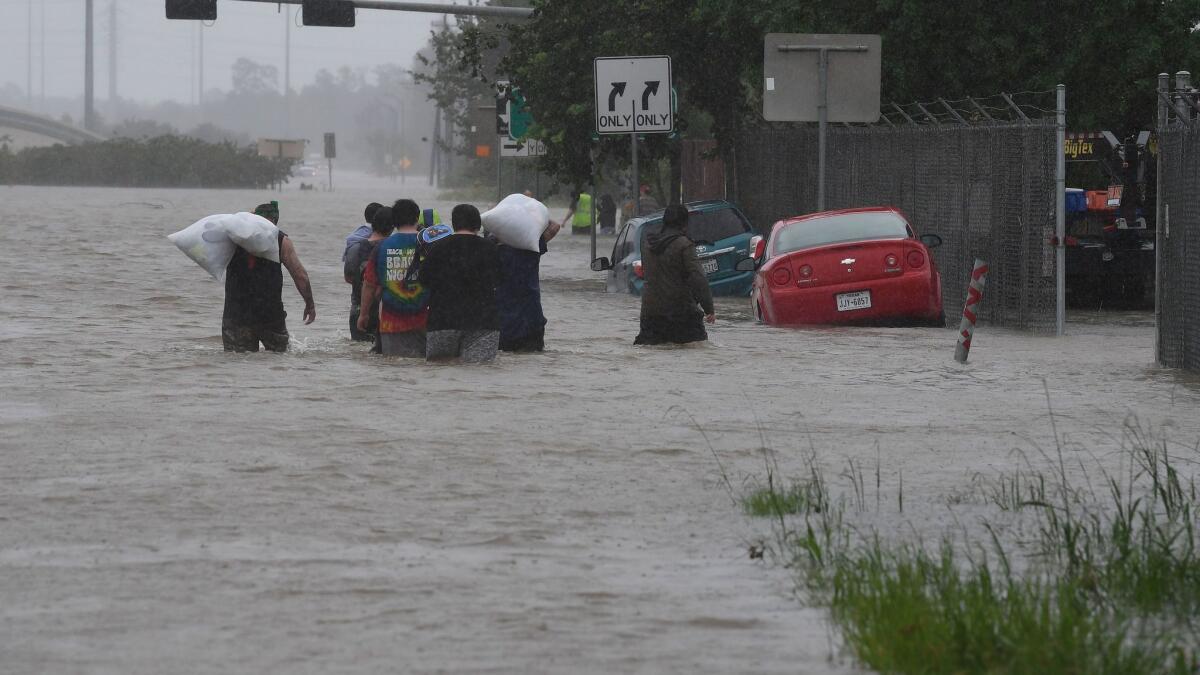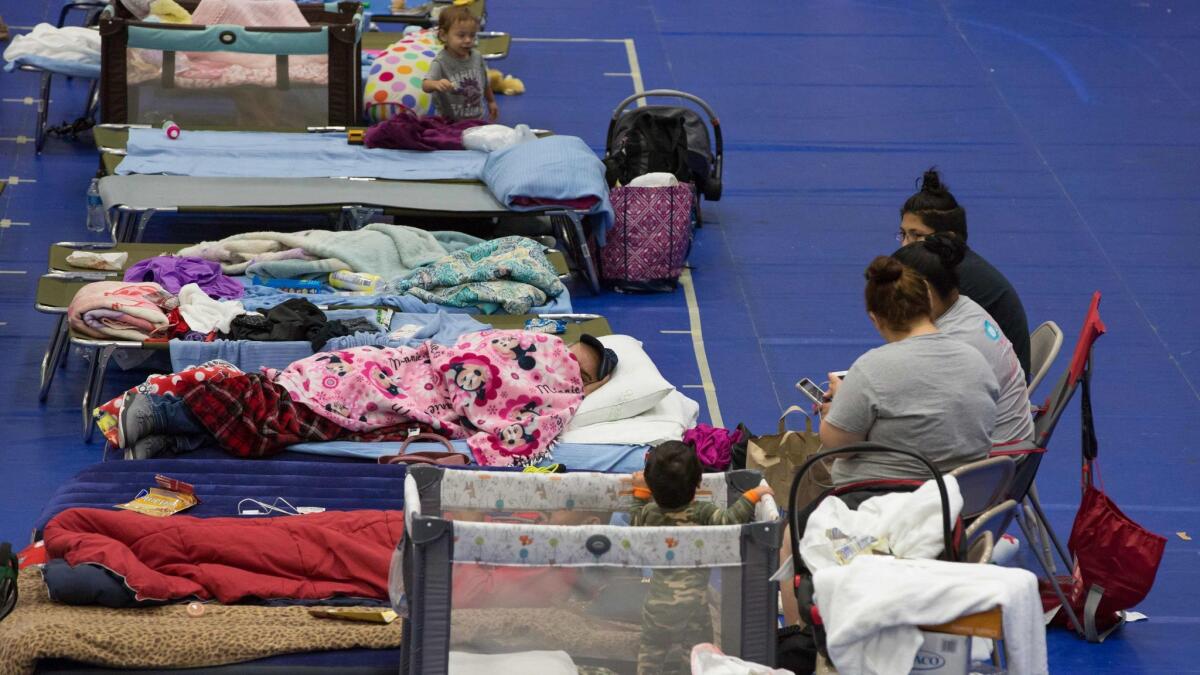Red Cross braces for weeks of relief effort in the face of colossal storm disaster
- Share via
In response to what is expected to rank among one of the most devastating hurricanes to strike the United States, the Red Cross has launched one of its largest hurricane relief efforts in years.
Harvey, which made landfall as a Category 4 hurricane and is now drenching Texas as a tropical storm, has triggered a massive deployment of the humanitarian agency’s resources and manpower. As of Monday morning, there were 1,600 Red Cross workers assigned to the relief operation in Texas, according to officials, and their ranks were expected to swell by at least an additional 1,000 personnel in the coming days.
“I believe firmly that this is a catastrophic event and indeed one of the most catastrophic events from a natural disaster perspective that I’ve seen in my lifetime,” said Brad Kieserman, vice president of disaster services operations and logistics for the American Red Cross.
Kieserman, who has more than three decades of experience in the field of emergency management and is managing the organization’s Harvey relief effort, spoke to The Times about the scope of the disaster and resulting challenges.
The interview has been edited for length and clarity.
How does this compare to anything you’ve experienced before in your career in emergency management?
This is a very unique disaster.
If you look at the area in which the high levels of rain are falling, this 35, 40, 50 inches of rain that are falling and the rivers that are coming out of their banks, it’s not unfair to say that Harvey has in many ways turned southeast Texas into an inland lake, and I think that’s what makes it a fundamentally unique and different and incredibly challenging response for all.
Could this be categorized as the worst disaster you’ve seen?
This is among the worst disasters I’ve ever seen. This is certainly in many respects one of the most complex responses I have ever seen, in large part because of the duration.
This flood is not going to be over when the rain stops on Thursday or Friday. (I hope it stops.) It’s really just beginning. We’re going to have areas that are flooded for weeks, and not just a few isolated areas. I really do think you’re going to see an area of thousands of square miles that’s going to be flooded well past Labor Day in the United States, well past the week after that.
I think that we will have large shelter populations in the thousands going into October, possibly even November.
And because of the timing, this is going to impact children going to school, businesses in the community. It’s going to impact the fabric of society in ways that I think [are] going to be challenging for people to understand.
That’s why I think this is among the worst [disasters], and certainly among the most complex responses, that I’ve ever seen.

What has been the biggest challenge in terms of coordination and logistics?
I think the biggest challenge for all of us responding right now, is getting from place to place, and more importantly getting to where people are in need. People are trapped in the attics of their homes. They’re trapped in areas that are surrounded by water. Our shelter locations are safe, but getting to them becomes virtually impossible because the roads are cut off by this incredible flooding.
Talking to my colleagues, the biggest challenge we’re all facing right now, simply put, is access and transportation.
It’s not that we don’t have enough cots or blankets or food on the ground. That is not the case. We have shelter supplies in Texas today for 50,000 people. We were able to put 5,000 cots in Dallas last night. But getting them into Houston, and getting our workers who are waiting to get into Houston to help people, that is a real challenge.
One of the reasons it’s a challenge is because the same resources that you would usually use to get people through high water, are the resources that are properly being used for emergency search and rescue.
How many people is the Red Cross currently assisting?
At midnight [on Sunday] we had over 6,000 people in 43 separate shelters in Texas. That includes two very large shelters that had populations of 1,700 — one in Houston itself.
Based on the reporting I’ve been getting since midnight last night, my estimate right now is that we will probably wake up tomorrow morning and see more than 10,000 people in shelters.
I believe the numbers are underreported because the situation on the ground is extremely chaotic, as people are being rescued and calling for help and being brought to safety, and then being taken to shelters. And there’s lots of folks around the state who are opening their homes, or their churches or synagogues or mosques to survivors of the disaster. So it’s going to take a few days before all of those folks are able to get to officially maintained shelters.
I think when we see everyone able to get to officially maintained shelters, we will likely see shelter populations in excess of 30,000.
Aside from manpower, how is the Red Cross assisting people?
In terms of cots and blankets and shelter supplies, we have brought enough shelter supplies into Texas for 50,000 people. In addition to that … we have several tens of thousands more of cots and blankets that are at pre-established warehouses.
We are beginning to do feeding with our partners, the Southern Baptists, and we have also brought about 100,000 shelf-stable meals that are ready to eat. All of those supplies were pre-positioned and are in the state.
The biggest challenge we have in some cases is getting them through the high water to the very specific places where they need to be. But the state of Texas and the counties are working with us. The Department of Defense is working with us. We are getting nothing but excellent cooperation from our partners to get resources where they’re needed. And I really appreciate that.

It’s no secret that the Red Cross has come under criticism in recent years for its disaster management. What has the organization learned from past experience that has been helpful for tackling this disaster?
There’s three major lessons learned from our past experience. The first is the one thing you can never get back in a disaster is time. That means when you see something like Hurricane Harvey developing, you don’t wait for the worst-case scenario to play out. You plan for that scenario. You resource for that scenario. And that’s what we did here.
We put enough resources in very early on for over 20,000 people in shelters which is why we have the [equipment] and the people in Texas today, because we have learned that you can never get time back in a disaster.
The second... is that the American Red Cross is a volunteer organization. That means the first priority is taking care of the people who take care of disaster survivors. And so we have made great strides in recommitting ourselves to being a volunteer-powered organization and focusing on the experience our volunteers have, their safety and their care.
The third lesson ... is that it takes a whole community to respond to any event, particularly a catastrophic event. And that means understanding that whether you’re an organization that’s been around for over 150 years, or you’re an organization that’s just established itself in response to a disaster, you’re not the team, you’re a part of the team. And that focus on partnerships with all levels of government, with other volunteer organizations, and recognizing that it’s a team effort and playing it as a team effort, that is an important lesson that we have taken away from all of the past experiences that we’ve had.
What kind of resources does the Red Cross need right now?
We’re an all-volunteer organization. It costs money to put thousands of volunteers into Texas, to put [in] people and [equipment], and then to be there, and to really be able to stay the duration with the people of Texas, because it’s going to be a long haul.
If people are feeling that they want to help, their philanthropic generosity is really the best way to do that, right now.
[In addition], if you have time, volunteer. You don’t have to volunteer to go to Texas. If people want to volunteer in their community, there’s no better time than now. Because with all eyes on Texas, we still have our friends and neighbors around the rest of the country to help every single day.
And if people want to give blood, that is another way in which they can really help.
ALSO
How to help the victims of Tropical Storm Harvey
An on-air rescue, and other memorable scenes from Houston’s historic floods
A founder of Black Lives Matter answers a question on many minds: Where did it go?
For more on global development news, see our Global Development Watch page, and follow me @AMSimmons1 on Twitter
More to Read
Sign up for Essential California
The most important California stories and recommendations in your inbox every morning.
You may occasionally receive promotional content from the Los Angeles Times.











